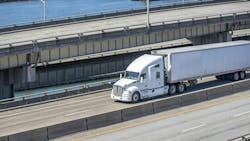How an all-in-one TMS and accounting solution can boost fleet finances
As a solution engineer and a formally trained accountant, I’ve had the opportunity to observe the trucking industry from both operational and financial perspectives. This combination of experience has underscored the role that accurate, streamlined financial management plays in a carrier’s success. One of the most impactful advances in recent years is the development of TMS platforms with built-in accounting, offering carriers a solution that saves time, reduces errors, and enhances financial control.
While many carriers still rely on separate systems, such as a TMS alongside QuickBooks, the benefits of a unified TMS with built-in accounting are undeniable. This approach is fast becoming the go-to choice for forward-thinking carriers.
Improved accuracy and efficiency
A unified TMS with accounting eliminates the need for manual data entry and the errors that can come with it. With operations and finance data flowing seamlessly in real-time, carriers maintain up-to-date, accurate financial records while saving time on repetitive tasks. This creates overall efficiency, allowing teams to focus on growth-oriented activities rather than error correction.
Real-time financial visibility
An all-in-one system provides complete visibility into the carrier’s revenue, expenses, and profitability at both the shipment and fleet levels. This comprehensive view enables data-driven decisions beyond operational insights, allowing carriers to assess profitability by customer or lane and make timely adjustments to support strategic growth.
Better cash flow control
With a unified TMS and accounting platform, carriers can monitor cash flow continuously, tracking income, expenses, and receivables in one place. This consolidated financial picture helps companies manage their finances dynamically and respond quickly to changes in the market. Cash flow visibility is essential in an industry where costs can fluctuate due to factors like fuel and maintenance.
Streamlined billing and collections
An all-in-one TMS with accounting makes the billing process more efficient by automating invoice generation based on shipment data. Carriers can track payment statuses in real-time, improving cash flow and reducing delays in receivables. This level of financial control strengthens relationships with customers and suppliers, as faster, more accurate billing establishes trust and improves reliability.
Simplified expense tracking
With a comprehensive TMS and accounting platform, carriers can automatically track and categorize expenses like fuel, maintenance, and driver wages. This visibility into cost drivers provides insights into where to reduce unnecessary spending and optimize profit margins. In a low-margin industry like trucking, these insights can substantially impact overall profitability.
See also: Fleets Explained: What is a TMS?
Streamlined compliance
Trucking companies face complex accounting and regulatory requirements, and a unified TMS with built-in accounting assists with compliance by automating tasks such as fuel tax reporting and hours of service tracking. This automation saves time and effort and reduces the risk of penalties and fines.
Reduced financial risk
When financial data is managed across separate systems, inconsistencies, and manual errors increase financial risk. By consolidating operations and financial data in a single system, carriers reduce the chance of discrepancies, creating a reliable source of financial truth that enhances accountability and improves credit relationships.
Scalability for growth
As carriers grow, managing data across multiple systems can become challenging. A unified TMS with accounting scales smoothly, allowing carriers to expand their fleets or services without adding back-office complexity. This scalability ensures that carriers can confidently pursue growth, knowing their financial platform will support them at every stage.
Long-term cost savings
Though the initial investment in a comprehensive TMS with built-in accounting may be higher than using separate tools, the long-term savings are substantial. Streamlined processes, fewer manual tasks, and improved cash flow all contribute to lower operational costs over time, making this solution a financially sound investment.
Conclusion
In today’s competitive trucking industry, technology that provides operational clarity and financial control is essential. A TMS with built-in accounting delivers improved data accuracy, real-time visibility, cash flow control, billing, compliance, and cost management—all while supporting scalable growth. For carriers looking to modernize and remain competitive, a unified approach offers the financial resilience needed for long-term success.
About the Author

Chase Carney
Chase Carney is a dedicated sales engineer at PCS Software, with over eight years of experience in the transportation software industry. He holds a bachelor of science in accountancy, which he uses to deliver solutions tailored to small fleet carriers. With a background that includes living in 15 different locations, Chase brings perspective and adaptability to his role.
